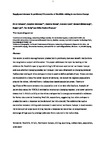Supply and demand in prehistory? Economics of Neolithic mining in northwest Europe
| dc.contributor.author | Schauer, P | |
| dc.contributor.author | Shennan, S | |
| dc.contributor.author | Bevan, A | |
| dc.contributor.author | Cook, G | |
| dc.contributor.author | Edinborough, K | |
| dc.contributor.author | Fyfe, R | |
| dc.contributor.author | Kerig, T | |
| dc.contributor.author | Parker Pearson, M | |
| dc.date.accessioned | 2019-04-04T12:01:17Z | |
| dc.date.issued | 2019-06 | |
| dc.identifier.issn | 0278-4165 | |
| dc.identifier.issn | 1090-2686 | |
| dc.identifier.uri | http://hdl.handle.net/10026.1/13636 | |
| dc.description.abstract |
The extent to which non-agricultural production in prehistory had cost-benefit motivations has long been a subject of discussion. This paper addresses the topic by looking at the evidence for Neolithic quarrying and mining in Britain and continental northwest Europe and asks whether changing production through time was influenced by changing demand. Radiocarbon dating of mine and quarry sites is used to define periods of use. These are then correlated with a likely first-order source of demand, the size of the regional populations around the mines, inferred from a radiocarbon-based population proxy. There are significant differences between the population and mine-date distributions. Analysis of pollen data using the REVEALS method to reconstruct changing regional land cover patterns shows that in Britain activity at the mines and quarries is strongly correlated with evidence for forest clearance by incoming Neolithic populations, suggesting that mine and quarry production were a response to the demand that this created. The evidence for such a correlation between mining and clearance in continental northwest Europe is much weaker. Here the start of large-scale mining may be a response to the arrival by long-distance exchange of high-quality prestige jade axes from a source in the Italian Alps. | |
| dc.format.extent | 149-160 | |
| dc.language | en | |
| dc.language.iso | en | |
| dc.publisher | Elsevier | |
| dc.subject | Neolithic | |
| dc.subject | Britain | |
| dc.subject | Northwest Europe | |
| dc.subject | Mining | |
| dc.subject | Quarrying | |
| dc.subject | Radiocarbon | |
| dc.subject | Population | |
| dc.subject | Land cover | |
| dc.title | Supply and demand in prehistory? Economics of Neolithic mining in northwest Europe | |
| dc.type | journal-article | |
| dc.type | Journal Article | |
| plymouth.author-url | https://www.webofscience.com/api/gateway?GWVersion=2&SrcApp=PARTNER_APP&SrcAuth=LinksAMR&KeyUT=WOS:000472987500010&DestLinkType=FullRecord&DestApp=ALL_WOS&UsrCustomerID=11bb513d99f797142bcfeffcc58ea008 | |
| plymouth.volume | 54 | |
| plymouth.publication-status | Published | |
| plymouth.journal | Journal of Anthropological Archaeology | |
| dc.identifier.doi | 10.1016/j.jaa.2019.03.001 | |
| plymouth.organisational-group | /Plymouth | |
| plymouth.organisational-group | /Plymouth/Admin Group - REF | |
| plymouth.organisational-group | /Plymouth/Admin Group - REF/REF Admin Group - FoSE | |
| plymouth.organisational-group | /Plymouth/Faculty of Science and Engineering | |
| plymouth.organisational-group | /Plymouth/Faculty of Science and Engineering/School of Geography, Earth and Environmental Sciences | |
| plymouth.organisational-group | /Plymouth/REF 2021 Researchers by UoA | |
| plymouth.organisational-group | /Plymouth/REF 2021 Researchers by UoA/UoA14 Geography and Environmental Studies | |
| plymouth.organisational-group | /Plymouth/Research Groups | |
| plymouth.organisational-group | /Plymouth/Research Groups/Marine Institute | |
| plymouth.organisational-group | /Plymouth/Users by role | |
| plymouth.organisational-group | /Plymouth/Users by role/Academics | |
| dcterms.dateAccepted | 2019-03-08 | |
| dc.rights.embargodate | 2020-9-28 | |
| dc.identifier.eissn | 1090-2686 | |
| dc.rights.embargoperiod | Not known | |
| rioxxterms.versionofrecord | 10.1016/j.jaa.2019.03.001 | |
| rioxxterms.licenseref.uri | http://www.rioxx.net/licenses/all-rights-reserved | |
| rioxxterms.licenseref.startdate | 2019-06 | |
| rioxxterms.type | Journal Article/Review |


